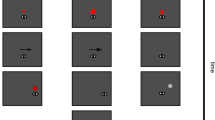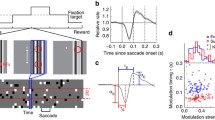Abstract
To view different objects of interest, primates use fast, accurate eye movements called saccades. If saccades become inaccurate, the brain adjusts their amplitudes so they again land on target, a process known as saccade adaptation. The different types of saccades elicited in different behavioral circumstances appear to utilize different parts of the oculomotor circuitry. To gain insight into where adaptation occurs in different saccade pathways, we adapted saccades of one type and examined how that adaptation affected or transferred to saccades of a different type. If adaptation of one type of saccade causes a substantial change in the amplitude of another, that adaptation may occur at a site used in the generation of both types of saccade. Alternatively, if adaptation of one type of saccade transfers only partially, or not at all, to another, adaptation occurs at least in part at a location that is not common to the generation of both types of saccade. We produced significant amplitude reductions in memory-guided, delayed, targeting and express saccades by moving the target backward during the saccade. After memory-guided saccades were adapted, the amplitude of express, targeting and delayed saccades exhibited only a partial reduction. In contrast, when express, targeting, or delayed saccades were adapted, amplitude transfer to memory-guided saccades was more substantial. These results, combined with previously published data, suggest that there are at least two sites of adaptation within the saccadic system. One is used communally in the generation of express, targeting, delayed and memory-guided saccades, whereas the other is specific for the generation of memory-guided saccades.








Similar content being viewed by others
Notes
Reactive saccades also have been called ‘reflexive’ (Pierrot-Deseilligny et al. 1991) or ‘externally triggered’ (Erkelens and Hulleman 1993). Because simple reflexes, like those seen in the somatomotor system, are essentially involuntary but these saccades are not, we prefer to call them “reactive”.
References
Abel L, Schmidt D, Dell’Osso L, Daroff R (1978) Saccadic system plasticity in human. Ann Neurol 4:313–318
Alahyane N, Salemme R, Urquizar C, Cotti J, Guillaume A, Vercher J-L, Péllison D (2007) Oculomotor plasticity: are mechanisms of adaptation for reactive and voluntary saccades separate? Brain Res 1135:107–121
Amador N, Schlag-Reh M, Schlag J (1998) Primate antisaccades. I. Behavioral consequences. J Neurophysiol 80:1775–1786
Becker W (1989) Metrics. In: Wurtz B, Goldberg M (eds) The neurobiology of saccadic eye movements. Elsevier, Amsterdam, pp 13–67
Bell A, Everling S, Munoz D (2000) Influence of stimulus eccentricity and direction on characteristics of pro- and antisaccades in non-human primates. J Neurophysiol 84:2595–2604
Braun D, Weber H, Mergner T, Schulte-Monting J (1992) Saccadic reaction times in patients with frontal and parietal lesions. Brain 115:1359–1386
Catz N, Dicke P, Thier P (2008) Cerebellar-dependent motor learning is based on pruning a Purkinje cell population response. Proc Natl Acad Sci USA 105:7309–7314
Deng, S, Goldberg, M, Segraves, M, Ungerleider, L, Mishkin, M (1985) The effect of unilateral ablation of the frontal eye fields on the saccadic performance in the monkey. In: Adaptive processes in visual and oculomotor systems. Pergamon, Oxford, pp 201–208
Deubel H (1994) Selective adaptation of intentional and reactive saccades. In: Fuchs A, Brandt Th, Büttner U, Zee D (eds) Contemporary ocular motor and vestibular research: a tribute to David A. Robinson. Thieme, Stuttgart, pp 206–208
Deubel H (1995a) Is saccadic adaptation context-specific? In: Findlay J, Kentridge R, Walker R (eds) Eye movement research: mechanisms, processes and applications. Elsevier, Amsterdam, pp 177–187
Deubel H (1995b) Separate adaptive mechanisms for the control of reactive and volitional saccadic eye movements. Vision Res 35:3529–3540
Deubel H (1999) Separate mechanisms for the adaptive control of reactive, volitional, and memory-guided saccadic eye movements. In: Gopher D, Koriat A (eds) Attention and performance XVII cognitive regulation of performance: interaction of theory and application. MIT Press, Cambridge, pp 697–721
Deubel H, Wolf W, Hauske G (1986) Adaptive gain control of saccadic eye movements. Human Neurobiol 5:245–253
Draper N, Smith H (1981) Applied regression analysis, 2nd edn. Wiley, New York, pp 97–98
Edelman J, Goldberg M (2002) Effect of short-term saccadic adaptation on saccades evoked by electrical stimulation of the primate superior colliculus. J Neurophysiol 87:1915–1923
Erkelens C, Hulleman J (1993) Selective adaptation of internally triggered saccades made to visual targets. Exp Brain Res 93:157–164
Fischer B, Weber H (1993) Express saccades and visual attention. Behav Brain Res 16:553–610
Fischer B, Weber H, Biscaldi M, Aiple F, Otto P, Stuhr V (1993) Separate populations of visually guided saccades in humans: reaction times and amplitudes. Exp Brain Res 92:528–541
Fisher B, Boch R (1983) Saccadic eye movements after extremely short reaction times. Brain Res 260:21–26
Fitzgibbon E, Goldberg M, Segraves M (1986) Short term adaptation in the monkey. In: Keller EL, Zee DS (eds) Adaptive processes in visual and oculomotor systems. Pergamon Press, Oxford, pp 329–333
Frens M, van Opstal A (1994) Transfer of short-term adaptation in human saccadic eye movements. Exp Brain Res 100:293–306
Frens M, van Opstal A (1997) Monkey superior colliculus activity during short-term saccadic adaptation. Brain Res Bull 43:473–483
Fuchs A, Reiner D, Pong M (1996) Transfer of gain changes from targeting to other types of saccade in the monkey: constraints on possible sites of saccadic gain adaptation. J Neurophysiol 74:2522–2535
Fujita M, Amagai A, Minakawa F, Aoki M (2002) Selective and delay adaptation of human saccades. Cog Brain Res 13:41–52
Fukushima K, Tanaka S, Williams J, Fukushima J (2005) Voluntary control of saccadic and smooth-pursuit eye movements in children with learning disorders. Brain Dev 27:579–588
Hopp J, Fuchs A (2002) Investigating the site of human saccadic gain adaptation with targeting and express saccades. Exp Brain Res 144:538–548
Hopp J, Fuchs A (2004) The characteristics and neuronal substrate of saccadic eye movement plasticity. Prog Neurobiol 72:27–53
Kommerell G, Oliver D, Theopold H (1976) Adaptive programming of phasic and tonic components in saccadic eye movements. Invest Ophthal 155:657–660
MacAskill M, Anderson T, Jones R (2002) Adaptive modification of saccade amplitude in Parkinson’s disease. Brain 125:1570–1582
McLaughlin S (1967) Parametric adjustment in saccadic eye movements. Percept Psychophys 2:359–362
Melis B, van Gisbergen J (1996) Short-term adaptation of electrically induced saccades in monkey superior colliculus. J Neurophysiol 76:1744–1758
Munoz D, Broughton J, Goldring J, Armstrong I (1998) Age-related performance of human subjects on saccadic eye movement tasks. Exp Brain Res 121:391–400
Pierrot-Deseilligny C, Rivaud S, Gaymard B, Agid Y (1991) Cortical control of memory-guided saccades in man. Exp Brain Res 83:607–617
Robinson DA (1963) A method of measuring eye movement using a scleral search coil in a magnetic field. IEEE Trans Biomed Elect, BME 10:137–145
Schiller P, Sandell J, Maunsell J (1987) The effect of frontal eye field and superior colliculus lesions on saccadic latencies in the rhesus monkey. J Neurophysiol 57:1033–1049
Scudder C, Kaneko C, Fuchs A (2002) The brainstem burst generator for saccadic eye movements: a modern synthesis. Exp Brain Res 142:439–462
Smit A, van Gisbergen A, Cools A (1987) A parametric analysis of human saccades in different experimental paradigms. Vision Res 27:1745–1762
Soetedjo R, Kojima Y, Fuchs A (2008) Complex spike activity in the oculomotor vermis: an error signal for saccade motor learning? J Neurophysiol 100:1949–1966
Straube A, Deubel H, Spuler A, Büttner U (1995) Differential effect of a bilateral deep cerebellar nuclei lesion on externally and internally triggered saccades in humans. Neuroophthalmology 15:67–74
Warabi T, Kase M, Kato T (1984) Effect of aging on the accuracy of visually guided saccadic eye movement. Ann Neurol 16:449–454
White J, Sparks D, Stanford T (1994) Saccades to remembered target locations: an analysis of systematic and variable errors. Vision Res 34:79–92
Acknowledgments
We appreciate the comments of our colleagues S. Bierer, C.R.S. Kaneko, Y. Kojima, L. Ling, J. Phillips, and R. Soetedjo on an early version of this manuscript. We also thank M. Ibarreta and R. Soetedjo for assistance with the figures. The material presented here was submitted in partial fulfillment of the Ph.D. requirements of the Department of Physiology and Biophysics at the University of Washington. This study was supported by the Vision Training Grant T32 EY07031 (JJH), RO1 EY00745 (AFF), NASA (NNA04CC60G), RR00166 from the National Center for Research Resources (NCRR), a component of the National Institutes of Health (NIH), and a University of Wisconsin—Stout Faculty Research Initiative Grant. Its contents are solely the responsibility of the authors and do not necessarily represent the official views of NCRR or NIH.
Author information
Authors and Affiliations
Corresponding author
Rights and permissions
About this article
Cite this article
Johanna Hopp, J., Fuchs, A.F. Identifying sites of saccade amplitude plasticity in humans: transfer of adaptation between different types of saccade. Exp Brain Res 202, 129–145 (2010). https://doi.org/10.1007/s00221-009-2118-5
Received:
Accepted:
Published:
Issue Date:
DOI: https://doi.org/10.1007/s00221-009-2118-5




